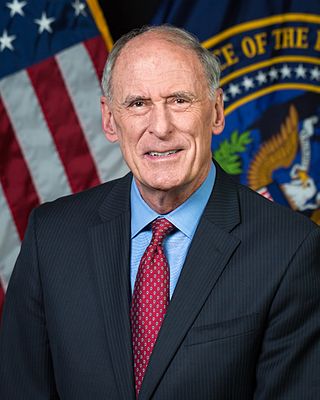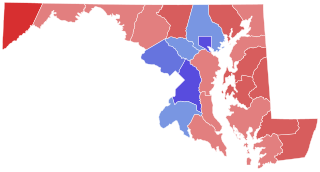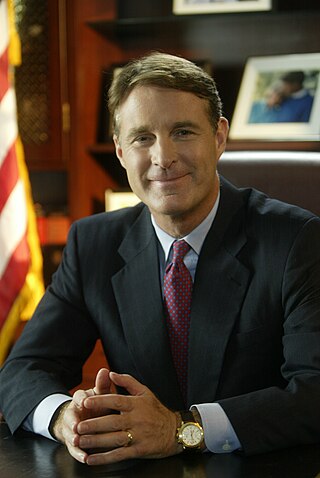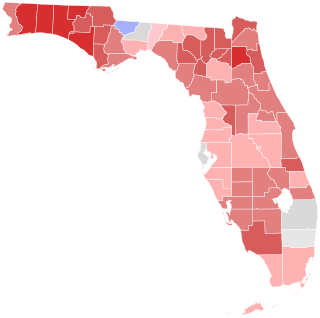
Daniel Ray Coats is an American politician, attorney, and diplomat. From 2017 to 2019, he served as the Director of National Intelligence in the Trump administration. A member of the Republican Party, he served as a United States Senator from Indiana from 1989 to 1999 and again from 2011 to 2017. He was the United States Ambassador to Germany from 2001 to 2005, and a member of the United States House of Representatives from 1981 to 1989. Coats served on the United States Senate Select Committee on Intelligence while in the U.S. Senate.

The 2006 United States Senate election in Ohio was held November 7, 2006. Incumbent Republican Mike DeWine ran for re-election, but was defeated by Democratic congressman Sherrod Brown. As of 2024, this is the most recent time a Democratic Senate candidate in Ohio won a race by double digits.

The 2006 United States Senate election in Maryland was held Tuesday, November 7, 2006. Incumbent Democrat Paul Sarbanes, Maryland's longest serving United States Senator, decided to retire instead of seeking a sixth term. Democratic nominee Ben Cardin, a U.S. Representative, won the open seat, defeating Republican Lieutenant Governor Michael Steele.

John Bradley Ellsworth is an American politician who was the U.S. representative for Indiana's 8th congressional district from 2007 to 2011. In 2010, he was the Democratic candidate for a seat in the United States Senate, but he was defeated by Dan Coats, a former Senator, by 55% to 40%.

John Nathan Hostettler is an American politician who served in the United States House of Representatives for 12 years, representing Indiana's 8th congressional district as a Republican. He lost his reelection bid for a seventh term to Democratic challenger Brad Ellsworth in the 2006 midterm election by a landslide.

Birch Evans "Evan" Bayh III is an American politician who served as the 46th governor of Indiana from 1989 to 1997 and as a United States senator representing Indiana from 1999 to 2011. A member of the Democratic Party, he currently serves on the President's Intelligence Advisory Board.
Indiana is rated R+11 on the Cook Partisan Voting Index. The current governor of Indiana is Republican Eric Holcomb, and Republicans hold supermajorities in both chambers of the Indiana General Assembly. It has only supported a Democrat for president four times since 1912—in the elections of 1932, 1936, 1964, and 2008. Historically, the state was a swing state, voting for the national winner all but four times from 1816 to 1912, with the exceptions of 1824, 1836, 1848, and 1876.

The 2010 United States Senate election in Kansas took place on November 2, 2010, alongside other elections to the United States Senate in other states as well as elections to the United States House of Representatives and various state and local elections. Incumbent Senator Sam Brownback did not seek a third full term, but instead successfully ran for Governor of Kansas.

The 2010 United States Senate election in Colorado took place on November 2, 2010, alongside other elections to the United States Senate in other states as well as elections to the United States House of Representatives and various state and local elections. In December 2008, President-elect Barack Obama nominated incumbent U.S. Senator Ken Salazar as Secretary of the Interior. After Salazar resigned from his seat, Democratic governor Bill Ritter appointed Denver Public Schools Superintendent Michael Bennet to fill the seat.

The 2010 United States Senate election in Florida took place on November 2, 2010, concurrently with other elections to the United States Senate in other states, as well as elections to the United States House of Representatives and various state and local elections.

The 2010 United States Senate election in Washington was held on November 2, 2010, alongside other elections to the United States Senate in other states as well as elections to the United States House of Representatives and various state and local elections. Incumbent Democrat Senator Patty Murray won re-election to a fourth term by a margin of 52.1% – 47.4% over Republican Dino Rossi, who had run for governor in 2004 and 2008. This was the last U.S. Senate election in Washington where the margin of victory was single digits.

The 2010 United States Senate election in Utah took place on November 2, 2010, along with other midterm elections throughout the United States. Incumbent Republican U.S. Senator Bob Bennett was seeking re-election to a fourth term, but lost renomination at the Republican Party's state convention. Mike Lee proceeded to win the Republican primary against Tim Bridgewater and the general election against Democrat Sam Granato. As of 2024, this is the most recent U.S. Senate election in which a political party held the seat after denying renomination to the incumbent senator.

The 2010 United States Senate election in Oregon was held on November 2, 2010, alongside other elections to the United States Senate in other states, as well as elections to the United States House of Representatives and various state and local elections. Incumbent Democratic U.S. Senator Ron Wyden won re-election to a third full term by a landslide margin of 18 points, despite the national Republican midterm wave. As of 2022, this is the only senate election since 1998 in which Deschutes County has not supported the Democratic candidate.

Marlin Andrew Stutzman is an American politician who was a member of the United States House of Representatives, representing Indiana's 3rd congressional district, from 2010 to 2017. A Republican, Stutzman previously served as a member of the Indiana House of Representatives from 2002 to 2008, representing district 52, and as a member of the Indiana Senate, representing the 13th district, from 2009 to 2010.
Elections were held in Indiana on Tuesday, November 2, 2010. Primary elections were held on May 4, 2010.

The 2010 congressional elections in Indiana were held on November 2, 2010, to determine who would represent the state of Indiana in the United States House of Representatives. Representatives are elected for two-year terms; those elected served in the 112th Congress from January 2011 until January 2013, except for the winner of the 3rd District's special election, who will serve the few remaining weeks of the 111th Congress. As of 2023 this is the last time that the Democrats won more than 2 seats in Indianas house delegation.

The 2012 United States Senate election in Indiana took place on November 6, 2012, concurrently with the U.S. presidential election as well as other elections to the United States Senate and House of Representatives, and various state and local elections.

The 2016 United States Senate election in Indiana was held on November 8, 2016, to elect a member of the United States Senate to represent the State of Indiana. The election was held alongside the presidential election and 2016 Indiana elections.

The 2016 Indiana gubernatorial election was held on November 8, 2016, to elect the governor and lieutenant governor of Indiana, concurrently with the 2016 U.S. presidential election as well as elections to the United States Senate and elections to the United States House of Representatives and various state and local elections. The primaries were held on May 3, 2016. Republican lieutenant governor Eric Holcomb won the race with 51.4% of the vote.

The 2022 United States Senate election in Indiana was held on November 8, 2022, to elect a member of the United States Senate to represent the state of Indiana. Incumbent Senator Todd Young won to a second term.























